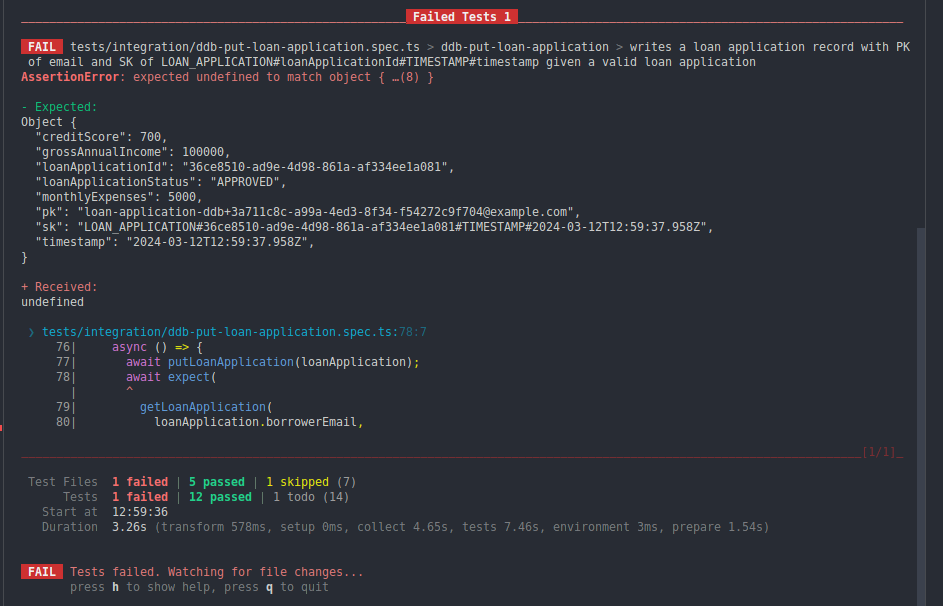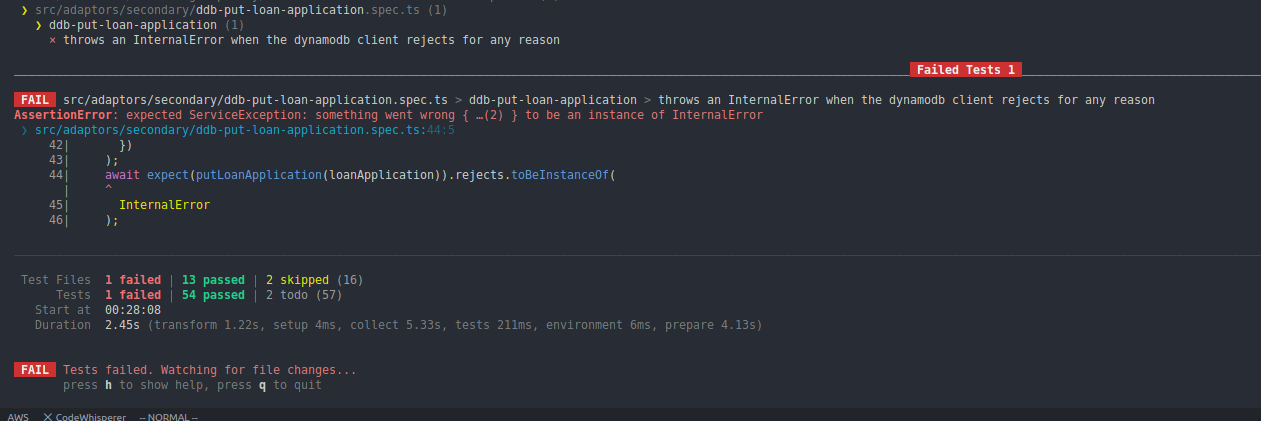Secondary Adapter
Examine the DynamoDBPutLoanApplication secondary port
import { EmploymentStatus } from '@/entities/EmploymentStatus';
import { LoanApplicationStatus } from '@/entities/LoanApplicationStatus';
export type PutLoanApplicationInput = {
loanApplicationId: string;
borrowerEmail: string;
timestamp: string;
creditScore: number;
grossAnnualIncome: number;
monthlyExpenses: number;
loanApplicationStatus: LoanApplicationStatus;
employmentStatus: EmploymentStatus;
};
export type PutLoanApplicationPort = (
loanApplication: PutLoanApplicationInput
) => Promise<void>;
Integration testing of the DynamoDBPutLoanApplication secondary port
Through the power of sst we can bring the deployed DynamoDB table into the test suite. This is done through the the SST Config client binding.
import { putLoanApplication } from '@/adaptors/secondary/ddb-put-loan-application';
import { PutLoanApplicationInput } from '@/ports/secondary/DynamoDBPutLoanApplication';
import {
DeleteItemCommand,
DynamoDBClient,
QueryCommand,
} from '@aws-sdk/client-dynamodb';
import { marshall, unmarshall } from '@aws-sdk/util-dynamodb';
import { randomUUID } from 'crypto';
import { Config } from 'sst/node/config';
import { afterEach, describe, expect, it } from 'vitest';
describe('ddb-put-loan-application', () => {
const financialDataTableName = Config.FINANCIAL_DATA_TABLE_NAME;
const client = new DynamoDBClient({});
// ...
});
Since we are dealing with the real Dyanamo table we will have to write some utilities to read in the eneties that were inserted into the table with our PUT secondary adaptor.
We have provided the GET uitility to be used in this test:
const getLoanApplication = (email: string, loanApplicationId: string) =>
client
.send(
new QueryCommand({
TableName: financialDataTableName,
KeyConditions: {
pk: {
ComparisonOperator: 'EQ',
AttributeValueList: [{ S: email }],
},
sk: {
ComparisonOperator: 'BEGINS_WITH',
AttributeValueList: [
{
S: `LOAN_APPLICATION#${loanApplicationId}`,
},
],
},
},
})
)
.then(({ Items }) => (Items?.length ? unmarshall(Items[0]!) : undefined));
import { putLoanApplication } from '@/adaptors/secondary/ddb-put-loan-application';
import { PutLoanApplicationInput } from '@/ports/secondary/DynamoDBPutLoanApplication';
import {
DeleteItemCommand,
DynamoDBClient,
QueryCommand,
} from '@aws-sdk/client-dynamodb';
import { marshall, unmarshall } from '@aws-sdk/util-dynamodb';
import { randomUUID } from 'crypto';
import { Config } from 'sst/node/config';
import { afterEach, describe, expect, it } from 'vitest';
describe('ddb-put-loan-application', () => {
const financialDataTableName = Config.FINANCIAL_DATA_TABLE_NAME;
const client = new DynamoDBClient({});
// ...
const loanApplication: PutLoanApplicationInput = {
borrowerEmail: `loan-application-ddb+${randomUUID()}@example.com`,
loanApplicationId: randomUUID(),
timestamp: new Date().toISOString(),
creditScore: 700,
grossAnnualIncome: 100000,
monthlyExpenses: 5000,
loanApplicationStatus: 'APPROVED',
employmentStatus: 'FULL_TIME',
};
// Cleans up the DynamoDB Table after each test case
afterEach(async () => {
await deleteLoanApplication(
loanApplication.borrowerEmail,
loanApplication.loanApplicationId
);
});
it(
'writes a loan application record with ' +
'PK of email and SK of LOAN_APPLICATION#loanApplicationId#TIMESTAMP#timestamp ' +
'given a valid loan application',
async () => {
// **Hint** Take a look at the following integration test:
// backend/tests/integration/ddb-put-borrowing-capacity-calculation.spec.ts
}
);
});
Solution
import { putLoanApplication } from '@/adaptors/secondary/ddb-put-loan-application';
import { PutLoanApplicationInput } from '@/ports/secondary/DynamoDBPutLoanApplication';
import {
DeleteItemCommand,
DynamoDBClient,
QueryCommand,
} from '@aws-sdk/client-dynamodb';
import { marshall, unmarshall } from '@aws-sdk/util-dynamodb';
import { randomUUID } from 'crypto';
import { Config } from 'sst/node/config';
import { afterEach, describe, expect, it } from 'vitest';
describe('ddb-put-loan-application', () => {
const financialDataTableName = Config.FINANCIAL_DATA_TABLE_NAME;
const client = new DynamoDBClient({});
const getLoanApplication = (email: string, loanApplicationId: string) =>
client
.send(
new QueryCommand({
TableName: financialDataTableName,
KeyConditions: {
pk: {
ComparisonOperator: 'EQ',
AttributeValueList: [{ S: email }],
},
sk: {
ComparisonOperator: 'BEGINS_WITH',
AttributeValueList: [
{
S: `LOAN_APPLICATION#${loanApplicationId}`,
},
],
},
},
})
)
.then(({ Items }) => (Items?.length ? unmarshall(Items[0]!) : undefined));
const deleteLoanApplication = (email: string, loanApplicationId: string) =>
getLoanApplication(email, loanApplicationId).then(
async (loanApplication) => {
if (loanApplication) {
await client.send(
new DeleteItemCommand({
TableName: financialDataTableName,
Key: marshall({
pk: email,
sk:
`LOAN_APPLICATION#${loanApplicationId}` +
`#TIMESTAMP#${loanApplication.timestamp}`,
}),
})
);
}
}
);
const loanApplication: PutLoanApplicationInput = {
borrowerEmail: `loan-application-ddb+${randomUUID()}@example.com`,
loanApplicationId: randomUUID(),
timestamp: new Date().toISOString(),
creditScore: 700,
grossAnnualIncome: 100000,
monthlyExpenses: 5000,
loanApplicationStatus: 'APPROVED',
employmentStatus: 'FULL_TIME',
};
afterEach(async () => {
await deleteLoanApplication(
loanApplication.borrowerEmail,
loanApplication.loanApplicationId
);
});
it(
'writes a loan application record with ' +
'PK of email and SK of LOAN_APPLICATION#loanApplicationId#TIMESTAMP#timestamp ' +
'given a valid loan application',
async () => {
await putLoanApplication(loanApplication);
await expect(
getLoanApplication(
loanApplication.borrowerEmail,
loanApplication.loanApplicationId
)
).resolves.toMatchObject({
pk: loanApplication.borrowerEmail,
sk:
`LOAN_APPLICATION#${loanApplication.loanApplicationId}` +
`#TIMESTAMP#${loanApplication.timestamp}`,
borrowerEmail: loanApplication.borrowerEmail,
loanApplicationId: loanApplication.loanApplicationId,
timestamp: loanApplication.timestamp,
creditScore: loanApplication.creditScore,
grossAnnualIncome: loanApplication.grossAnnualIncome,
monthlyExpenses: loanApplication.monthlyExpenses,
loanApplicationStatus: loanApplication.loanApplicationStatus,
employmentStatus: loanApplication.employmentStatus,
});
}
);
});
Start the test watcher
Run the following command:
pnpm run test:integration
You should see a failing test case, similar to the following:

Make the failing integration test pass
Navigate to backend/src/adaptors/secondary/ddb-put-loan-application.ts.
You'll need to issue a DynamoDB PutItemCommand to persist the LoanApplication entity.
Note: The
LoanApplicationentity has apkconsisting of the borrower's email. Theskis formatted as follows:LOAN_APPLICATION#<loan-application-id>#TIMESTAMP#<timestamp>
Hint
backend/src/adaptors/secondary/ddb-put-borrowing-capacity-calculation.ts secondary adapter.Solution
import { InternalError } from '@/errors/InternalError';
import { PutLoanApplicationPort } from '@/ports/secondary/DynamoDBPutLoanApplication';
import { DynamoDBClient, PutItemCommand } from '@aws-sdk/client-dynamodb';
import { marshall } from '@aws-sdk/util-dynamodb';
import { Config } from 'sst/node/config';
const dynamoDbClient = new DynamoDBClient();
export const putLoanApplication: PutLoanApplicationPort = async ({
borrowerEmail,
loanApplicationId,
timestamp,
creditScore,
grossAnnualIncome,
monthlyExpenses,
loanApplicationStatus,
employmentStatus,
}) => {
await dynamoDbClient.send(
new PutItemCommand({
TableName: Config.FINANCIAL_DATA_TABLE_NAME,
Item: marshall({
pk: borrowerEmail,
sk: `LOAN_APPLICATION#${loanApplicationId}#TIMESTAMP#${timestamp}`,
borrowerEmail,
loanApplicationId,
timestamp,
creditScore,
grossAnnualIncome,
monthlyExpenses,
loanApplicationStatus,
employmentStatus,
}),
})
);
};
But wait, there's more!
We're violating the port's interface if we let DynamoDB errors bubble up into the use case. The use case should only be concerned with domain entities and errors. Unfortunately, we can't force DynamoDB to fail on demand.
Question: Can you think of a way to simulate a DynamoDB failure?
Answer
mocks, then you're on the right track!Navigate to the unit test for the secondary adapter: backend/src/adaptors/secondary/ddb-put-loan-application.spec.ts.
We should avoid propagating DynamoDB errors into our use case. For this reason, we need to catch any such errors, and re-throw a domain specific error that can be handled deterministically in the use case.
describe('ddb-put-loan-application', () => {
vi.mock('sst/node/config', () => ({
Config: {
FINANCIAL_DATA_TABLE_NAME: 'financial-data-table',
},
}));
const dynamoDbMock = mockClient(DynamoDBClient);
beforeEach(() => {
dynamoDbMock.reset();
});
const loanApplication: PutLoanApplicationInput = {
borrowerEmail: 'john.doe@example.com',
creditScore: 700,
employmentStatus: 'FULL_TIME',
grossAnnualIncome: 100000,
loanApplicationId: 'd5fe6ff5-20b3-4581-b38f-9b034c20d783',
loanApplicationStatus: 'APPROVED',
monthlyExpenses: 5000,
timestamp: '2024-03-15T00:00:00.000Z',
};
it('throws an InternalError when the dynamodb client rejects for any reason', async () => {
dynamoDbMock.rejects(
new DynamoDBServiceException({
message: 'something went wrong',
$metadata: {},
name: 'ServiceException',
$fault: 'client',
})
);
await expect(putLoanApplication(loanApplication)).rejects.toBeInstanceOf(
InternalError
);
});
});
Start the test watcher
If your tests are not running, issue the following command:
pnpm run test
You should see a failing test case, similar to the following:

Make the failing unit test pass
Navigate to backend/src/adaptors/secondary/ddb-put-loan-application.ts.
You'll need wrap the call to dynamoDBClient.send(...) with a try/catch block.
Hint
InternalError instead.Solution
try {
await dynamoDbClient.send(
new PutItemCommand({
TableName: Config.FINANCIAL_DATA_TABLE_NAME,
Item: marshall({
pk: borrowerEmail,
sk: `LOAN_APPLICATION#${loanApplicationId}#TIMESTAMP#${timestamp}`,
loanApplicationId,
timestamp,
creditScore,
grossAnnualIncome,
monthlyExpenses,
loanApplicationStatus,
employmentStatus,
}),
})
);
} catch (e) {
throw new InternalError(
'Failed to put loan application to financial data table'
);
}